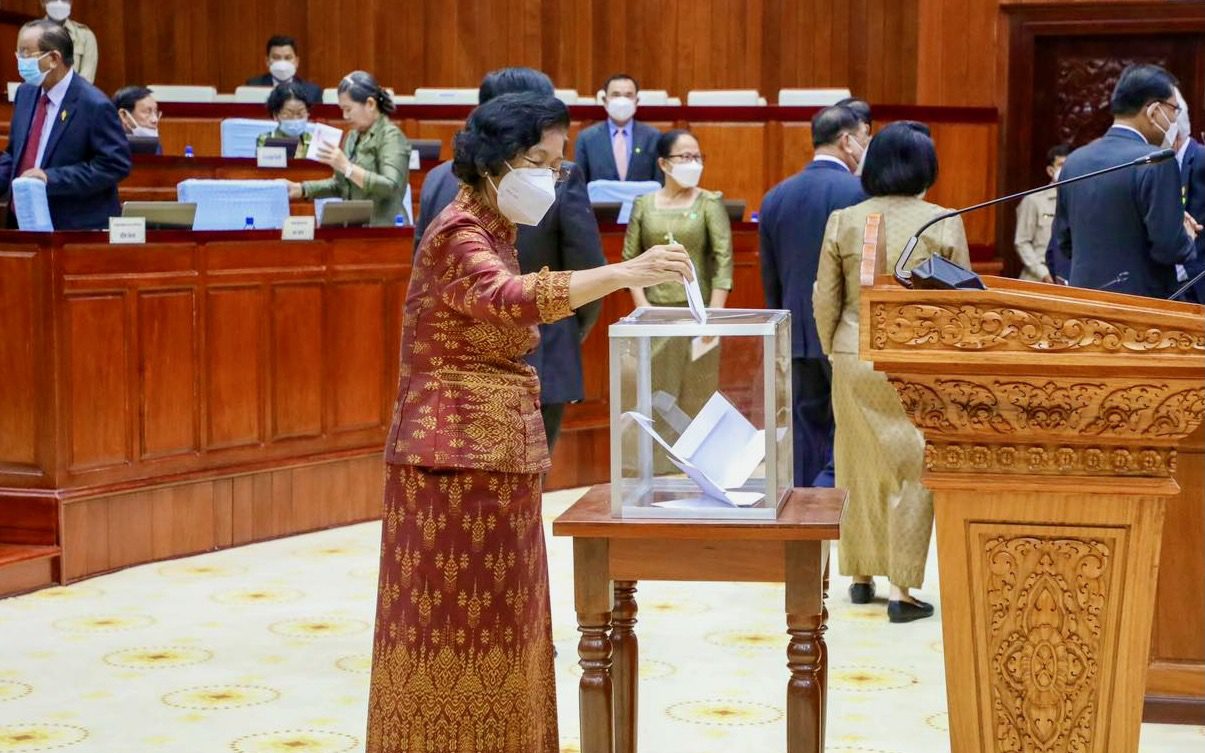It’s important to celebrate the progress that has taken place — UNDP data indicates that between 2017 to 2019 the share of women workers who are in managerial roles increased from 0.9% to 2%. But this still remains well below the 5.9% figure for men.
 Heng Molika is a junior research fellow at Future Forum.
Heng Molika is a junior research fellow at Future Forum.
Real challenges remain for Cambodia to achieve true gender equality and economic inclusion. Barriers holding women back include lack of access to job opportunities, occupational segregation and a gender pay gap in the job market, as noted in the World Bank’s 2020 Gender Analysis of the Cambodian Labor Market. In Cambodia, leadership and well-paid roles are still mainly held by men while women are left with lower positions, unable to rise in the ranks. As a result, Cambodian women do not have access to the same number and diversity of options when it comes to job opportunities compared to Cambodian men.
Work culture does not help this lack of access to these higher-paid roles. As in the political arena, business relationships are often developed or maintained in traditionally “men-dominated spaces,” in entertainment centers, over drinks or karaoke. Networking that takes place in these spaces can make it harder for women to be accepted as part of the team at the top levels.
Moreover, in their role as husbands, some Cambodian men continue to be a barrier to their wives’ success outside of the home. “It’s the role of women to take care [of the] home, it must be like that! In fact, we need to divide the tasks, household chores and the work outside … if we mix it up, we can’t do many things!” said a male respondent in a 2019 study examining the lack of women in leadership roles in Cambodia’s health care workforce.
That’s why Cambodia should adopt gender quotas policy in the workplace: Cultural barriers to greater women’s equality require a major shake-up to dislodge, and quotas — whether mandatory or voluntary — have been necessary globally to make even gradual progress.
Leading by Example
Many countries have adopted policy-mandated gender quotas in both private and public enterprises. Norway in 2003 was the first country to adopt a gender quota, requiring a 40% female board of directors representation in publicly listed and state-owned companies. In Norway, gender quotas were mandatory and companies penalized for noncompliance, and delivered a noticeable increase of women on boards from approximately 6% in 2002 to 40% in 2008.
Kenya’s gender quota also serves as a good example of the kind of impact this policy can have. Since 2010, the Constitution of Kenya required all businesses to have no more than two-thirds of their board members of one gender. After the enactment of the constitution, the proportion of women representation in boardrooms increased from 14% in 2012 to 21% in 2017.
That gave Kenya the highest percentage of women board members in the region, despite the law mandating no penalties for noncompliance — making the quota regime voluntary in practice — and despite the overall share still falling short of the one-third target.
A third example is India. The 2013 Company Act in India required listed companies and other large public companies to appoint at least one woman to their boards by 2015. Non-compliant companies faced fines ranging from approximately $790 to $2,240.
Most Indian companies only met the minimum requirement. Four years on from that law, only 16% of Indian companies had more than one woman on their board. But that is still an increase, and shows the importance of setting an ambitious enough target as companies have been shown to only do the bare minimum.
Backlash
Gender quotas have faced challenges largely in compliance.
In Norway, after the quota was implemented, a number of companies delisted from the stock exchange. Other companies began to register in the U.K. rather than Norway. The same women were being appointed to multiple boards, while some companies reduced the size of their boards to increase the share of women without actually adding any more, according to an ILO review.
One option is a voluntary regime. The U.K., Australia and Spain have reported success with voluntary quotas. Instead of imposing penalties, Spain, for example, encourages companies to meet targets by offering incentives such as preference for the tendering of public contracts. Progress can be slower, but such designs can still create opportunities for women with fewer downsides.
In the political arena, gender quotas for elected politicians have also created a backlash both from the public and from elites. A study on Kenyan politicians found women candidates being slandered as “loose” and as “prostitutes,” and some have been assaulted by male rivals. The entry of women into male-dominated spaces creates resistance. In California, even quotas for company boards have been criticized as promoting individuals without merit.
But the need for quotas remains. Globally, the share of women on company boards remains at just 19.7%. That’s up 2.8 percentage points since 2018, and 4.7 percentage points since 2016, as more countries around the world impose both voluntary and mandatory quotas.
The countries doing well all have quotas in place: France at 43.2%, Norway with 42.4%, Italy at 36.6% and Belgium at 34.9%.
Need for Change
Cambodia has not yet adopted any gender quota policies. Some initiatives have appeared in the public sector, such as the Civil Service Ministry announcing in 2019 that women must make up between 20% and 50% of the ministry’s new recruits in order to encourage women’s participation in social and economic development. But there is still a long way to go, and gender quotas will help bring about change.
In 2020, Cambodia’s gender pay gap was estimated to be roughly between 17% and 22%, meaning that women workers earn less per hour compared to their counterparts who are men. This shows that there is systemic gender discrimination and that women’s work is being undervalued.
A good place to start when it comes to quotas is state-owned enterprises, where the government has significant control through full, majority, or significant minority ownership. This is an easy way to set a good example for the private sector before bringing in country-wide regulations. Another good place to start is with leadership and management positions, which have no gender-based skill requirements, and therefore no excuse for discrimination.
More women in management and leadership roles would not fix every form of gender inequality women face, but it is still an important step to greater economic inclusion on the part of women. Women in leadership positions would have the ability to promote better working conditions for women who work for them and create gender-aware support systems in the workplace. Their women employees would have the opportunity to look up the ladder and see faces like theirs at the top.
Heng Molika is a junior research fellow at Future Forum.













